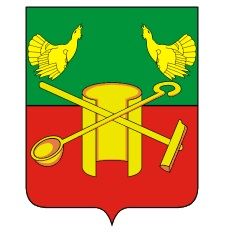Kolchugino

The city of Kolchugino is the administrative center of the Kolchuginsky district of the Vladimir region with a population of 43,784 people (2016). It is located on the river Peksha (tributary of Klyazma), 74 km to the north-west from Vladimir.
History
Kolchugino is a relatively young industrial city. It was founded in 1871 as a settlement at the copper smelting plant, owned by A.G. Kolchugin, near the village of Vasilievsky on the Belenkaya River, which flows into Peksha. These forest lands were scarce for agriculture, since so long the main source of livelihood for the inhabitants were various crafts. Already from the 16th century, blacksmith's and copper crafts, mentioned in the scribes books, were widespread in local villages. It is not by chance that the modern coat of arms of Kolchugino depicts two wood grouses, which talks about rich forest lands around the city, as well as a folded sheet of copper, on which a hammer and a ladle are laid across, symbolizing copper and brass crafts that gave rise to the city.
On behalf of the founder of copper-brass production, Moscow businessman, merchant of the second guild, A.G. Kolchugin (1839-1899), the workmen’s village at the plant (now – "Kolchugtsvetmet") was called Kolchuginsky. Since 1876, the " Partnership of Brass and Copper-Rolling Kolchugin’s Plants" began to develop rapidly, and with it – the workmen’s village. During the decade numerous brick and wooden single and double-storey houses were built for specialists, large barracks-dormitories for workers, a canteen, a bath, a hospital, a school.
In 1896 a section of the Aleksandrov-Kineshma railway opened nearby, which significantly accelerated the development of the plant and village. Since the middle of the 1890's, the largest non-ferrous metals processing plant in Russia was carrying out orders from the Russian Navy Department (producing nickel and copper blanks and sheets, elements for shells, cartridge bullet, and field pots). During the First World War, the Kolchugin’s plants worked entirely for military needs, being the main supplier of cable products (telephone, signal, mine and other cables). In 1918 the plants were nationalized.
In the years 1924-1925, the first capital apartment buildings appeared in the village of Kolchuginsky. Especially rapid development of the settlement was in the 1930s. In 1931 the village received the status of the city Kolchugino.
In 1937, an airfield was equipped and an aeroclub was opened near Kolchugino, which existed until 1942. In five years, it trained more than 300 civilian and military pilots.
In the 1950's and 1960's, the active development of vacant areas of Vasilievsky village began near Kolchugino. In 1977, a dam was built on the river Pekha and the Kolchugin Reservoir was opened. Since the 1990's, the construction of brick multi-storey buildings began on the territory of the former airfield. In 2001, the town included the village of Belaya Rechka.
Economy
The basis of the Kolchugino's economy is the production of non-ferrous metallurgy, which historically developed here. A large plant "Kolchugtsvetmet" named after Sergo Ordzhonikidze (former metallurgical plant of A.G. Kolchugin), until recently, produced about 30% of the total volume of rolled non-ferrous metals in Russia, not only in the form of pipes, profiles and wire, but also the famous cupronickel cupholders with which the railway trains are equipped, appliances, dishes. Kolchugino plant "Electrocable" produces a variety of cables and wires –cables that are used for laying in the Far North, for the needs of the civilian fleet, in engineering, energy, oil and chemical industries. Kolchugin cables are used even in the construction of stadiums for the upcoming football World Cup. In May 2017, reorganization took place in the form of the merger of CJSC "Kolchugtsvetmet" with JSC "Elektrokabel Kolchuginsky Zavod", which is part of the "Cable Alliance holding company" (the Ural Mining and Metallurgical Company). At the same time, the workplaces of the former "Kolchugtsvetmet" and the production of unique cupronickel ware will be preserved, and the production of cable and wire products will expand. At the enterprise "Intercilverline" (silver factory "Argenta") silverware is produced – cutlery, crockery and souvenirs. Jewelery and souvenirs made of gold and silver are produced in the modern high-tech jewelery plant "Adamant".
Sights
There are interesting attractions for tourists in Kolchugino: the Church of the Intercession of the Virgin (1792); the tower in the form of a samovar (1922, architect A.P. Vereshchagin), which was built as a water tower, but for some time served as a television tower; one of the first in the USSR monument of V.I. Lenin (1925, sculptor M. Ya. Kharlamov); monument to AG. Kolchugin, the founder of the copper-brass plant and the city (2006, sculptor V.I. Fedorin), etc.
 Tourism portal of the
Tourism portal of the